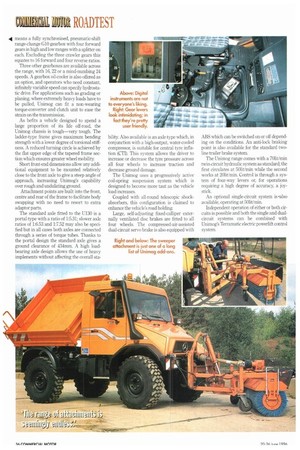CUM 2Y112. ROADTEST
Page 38

If you've noticed an error in this article please click here to report it so we can fix it.
means a fully synchronised, pneumatic-shift range-change G10 gearbox with four forward gears in high and low ranges with a splitter on each. Excluding the three crawler gears this equates to 16 forward and four reverse ratios.
Three other gearboxes are available across the range, with 16, 22 or a mind-numbing 24 speeds. A gearbox oil-cooler is also offered as an option, and operators who need constant, infinitely variable speed can specify hydrostatic drive. For applications such as grading or planing, where extremely heavy loads have to be pulled, Unimog can fit a non-wearing torque-converter and clutch unit to ease the strain on the transmission.
As befits a vehicle designed to spend a large proportion of its life off-road, the Unimog chassis is tough—very tough. The ladder-type frame gives maximum bending strength with a lower degree of torsional stiffness. A reduced turning circle is achieved by the flat upper edge of the tapered frame section which ensures greater wheel mobility Short front-end dimensions allow any additional equipment to be mounted relatively close to the front axle to give a steep angle of approach, increasing Unimog's capability over rough and undulating ground.
Attachment points are built into the front, centre and rear of the frame to facilitate body swapping with no need to resort to extra adaptor parts.
The standard axle fitted to the U130 is a portal-type with a ratio of 1:5.31; slower axle ratios of 1:6.53 and 1:7.52 may also be specified but in all cases both axles are connected through a series of torque tubes. Thanks to the portal design the standard axle gives a ground clearance of 434mm. A high loadbearing axle design allows the use of heavy implements without affecting the overall sta
bility. Also available is an axle type which, in conjunction with a high-output, water-cooled compressor, is suitable for central tyre inflation (CT!). This system allows the driver to increase or decrease the tyre pressure across all four wheels to increase traction and decrease ground damage.
The Unimog uses a progressively active coil-spring suspension system which is designed to become more taut as the vehicle load increases.
Coupled with all-round telescopic shockabsorbers, this configuration is claimed to enhance the vehicle's road holding.
Large, self-adjusting fixed-calliper externally ventilated disc brakes are fitted to all four wheels. The compressed-air-assisted dual-circuit servo brake is also equipped with .ABS which can be switched on or off depending on the conditions. An anti-lock braking point is also available for the standard twoline trailer brake system.
The Unimog range comes with a 70lithnin twin-circuit hydraulic system as standard; the first circulates at 501itimin while the second works at 201ib'min. Control is through a system of four-way levers or, for operations requiring a high degree of accuracy, a joystick.
An optional single-circuit system is•also available, operating at 501itimin.
Independent operation of either or both circuits is possible and both the single and dualcircuit systems can be combined with Unit-noes Terramatic electric powerlift control system.
















































































































